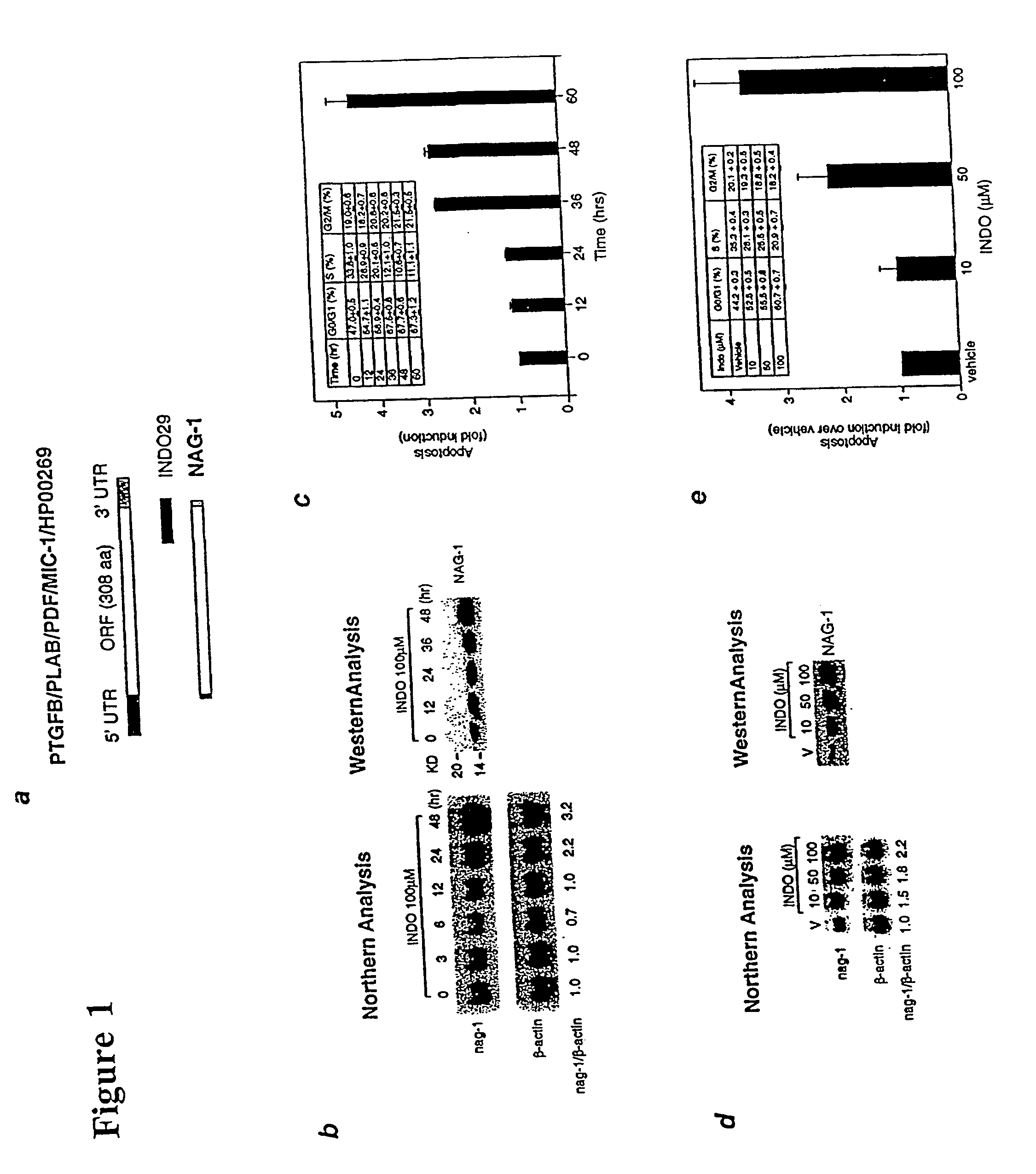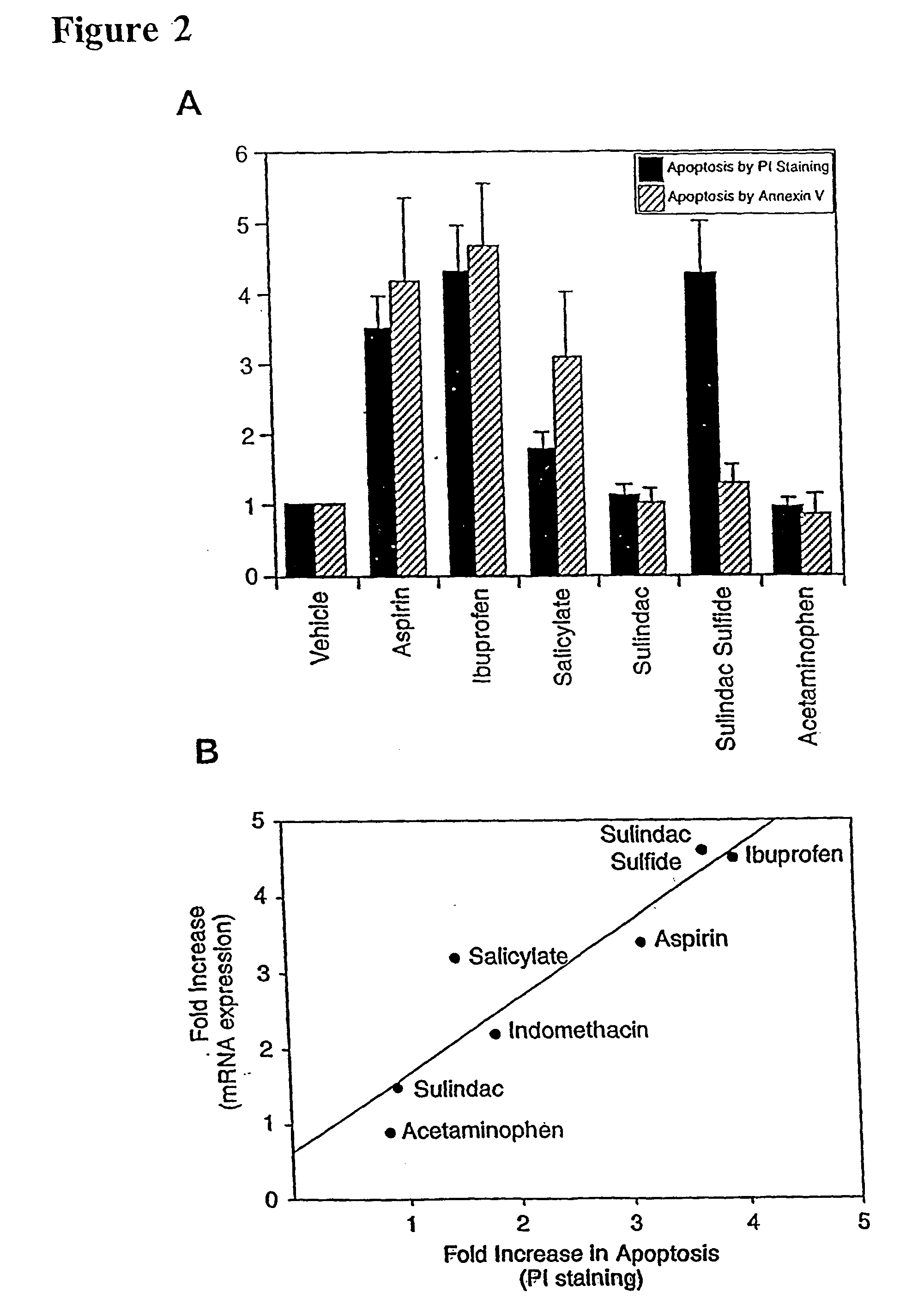Non-steroidal anti-inflammatory drug activated gene with anti-tumorigenic properties
a non-steroidal anti-inflammatory and gene activation technology, applied in the direction of drug composition, biological material analysis, apoptosis related proteins, etc., can solve the problem of insufficient information regarding the nsaid-induced or associated anti-cancer pathway, and achieve the effect of eliminating or reducing cancers, facilitating determination of potential side effects, and reliable enterozoa comparison
- Summary
- Abstract
- Description
- Claims
- Application Information
AI Technical Summary
Benefits of technology
Problems solved by technology
Method used
Image
Examples
example 2
NAG-1 Expression and Apoptosis Induced by Indomethacin is Dose- and Time-Dependent.
[0129] To confirm the increased expression of NAG-1 by INDO, Northern and Western blot analyses were performed using HCT-116 cells treated with 100 .mu.M INDO for varying times, as follows. Upon reaching 60-80% confluence in 10 cm plates, the cells were treated at indicated concentrations and times with either different NSAIDs or PPAR.gamma. ligands in the absence of serum. Total RNAs were isolated using TRIzol reagent (Life Technologies) according to the manufacturer's protocol. For Northern blot analysis, 10 mg of total RNA was denatured at 55.degree. C. for 15 min and separated in a 1.2% agarose gel containing 2.2 M formaldehyde, and transferred to Hybond-N membrane (Amersham). After fixing the membrane by UV, blots were prehybridized in hybridization solution (Rapid-hyb buffer, Amersham) for 1 hr at 65.degree. C. followed by hybridization with cDNA labeled with [.alpha.-.sup.32P]dCTP by random pri...
example 3
Stimulation of NAG-1 Expression and Apoptosis by Other NSAIDs
[0135] To determine whether other NSAIDs increased apoptosis and NAG-1 expression, tests were conducted to determine whether variants of NSAIDs induced NAG-1 gene expression and NSAID-induced apoptosis. Aspirin, ibuprofen, indomethacin, and sulindac sulfide were selected since they are known COX inhibitors. Sulindac, acetaminophen and sodium salicylate were also tested since these drugs are weak COX inhibitors but are reported to induce apoptosis. HCT-116 cells were treated with different NSAIDs (vehicle, 0.2% DMSO; aspirin, 10 mM; ibuprofen, 1 mM; sodium salicylate, 5 mM; sulindac sulfide, 50 .mu.M; sulindac, 40 .mu.M; acetaminophen, 100 .mu.M) for 24 hr in the absence of serum. Northern analysis was performed using NAG-1 and .beta.-actin as probes. Total RNAs were isolated from NSAID-treated HCT-116 cells after 24 hr treatment and Northern blot was performed using NAG-1 cDNA as a probe (data not shown). Each NSAID was te...
example 4
NAG-1 Induction by NSAIDs in Lung, Breast, Leukemia, and Prostate Cells
[0138] NSAID-induced apoptosis is not restricted to colorectal cells, as NSAIDs can induce apoptosis in breast, lung, leukemia, and prostate cell lines. To test for the induction of NAG-1 by NSAIDs in different cell lines, A549 lung epithelial cells, MCF-7 mammary cells, PC-3 prostate cancer cells, and U937 leukemia cell lines were treated with several concentrations of INDO and aspirin. Then, as described above, Northern blot analysis was performed. As shown in FIG. 3, NAG-1 was induced in different cell lines, A549 lung carcinoma cells (A), MCF-7 breast carcinoma cells (B), U937 leukemia cells (C), and PC-3 prostate cells (D). Quiescent cells were grown for 24 hr in the presence of indicated NSAIDs. Total RNAs were isolated and subjected to Northern analysis using NAG-1 and .beta.-actin as probes. The blots contained 10 .mu.g of total RNA from INDO- or Aspirin (Asp)-treated cells with indicated doses. "V" indic...
PUM
 Login to View More
Login to View More Abstract
Description
Claims
Application Information
 Login to View More
Login to View More - Generate Ideas
- Intellectual Property
- Life Sciences
- Materials
- Tech Scout
- Unparalleled Data Quality
- Higher Quality Content
- 60% Fewer Hallucinations
Browse by: Latest US Patents, China's latest patents, Technical Efficacy Thesaurus, Application Domain, Technology Topic, Popular Technical Reports.
© 2025 PatSnap. All rights reserved.Legal|Privacy policy|Modern Slavery Act Transparency Statement|Sitemap|About US| Contact US: help@patsnap.com



